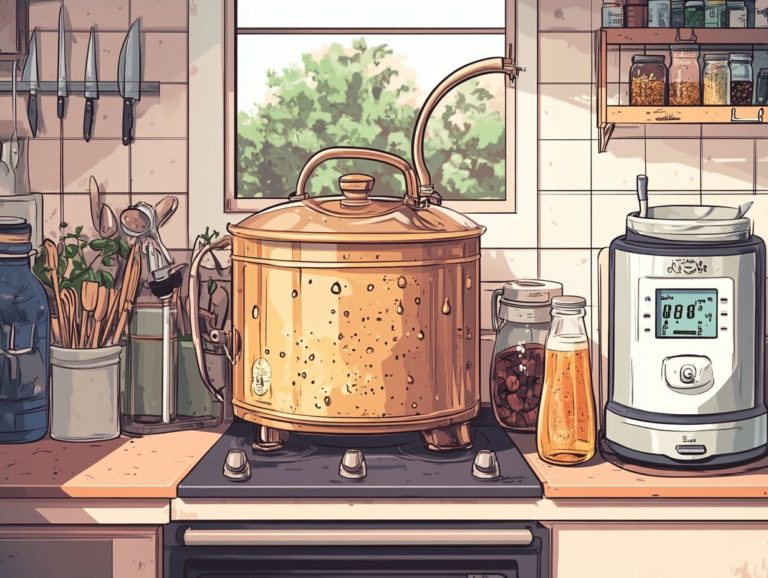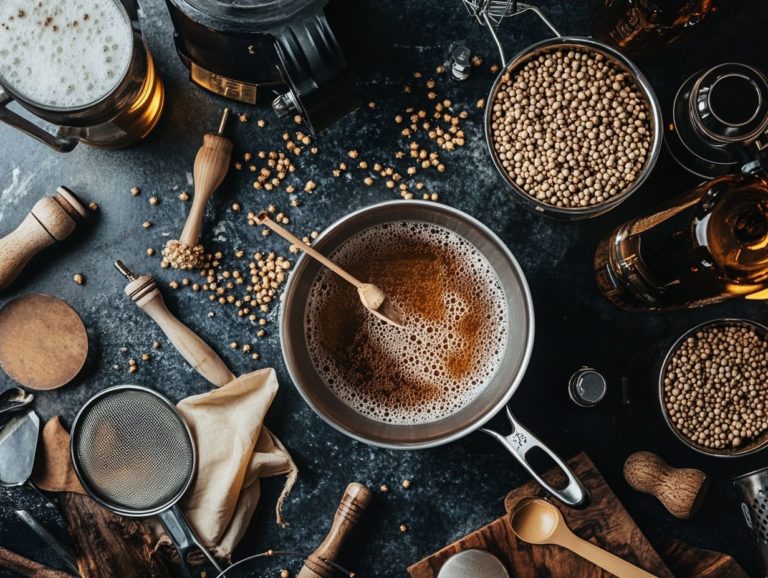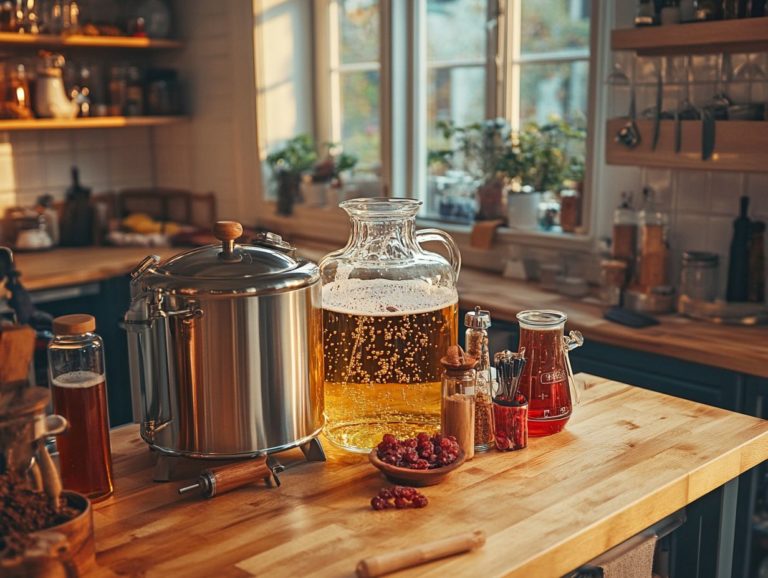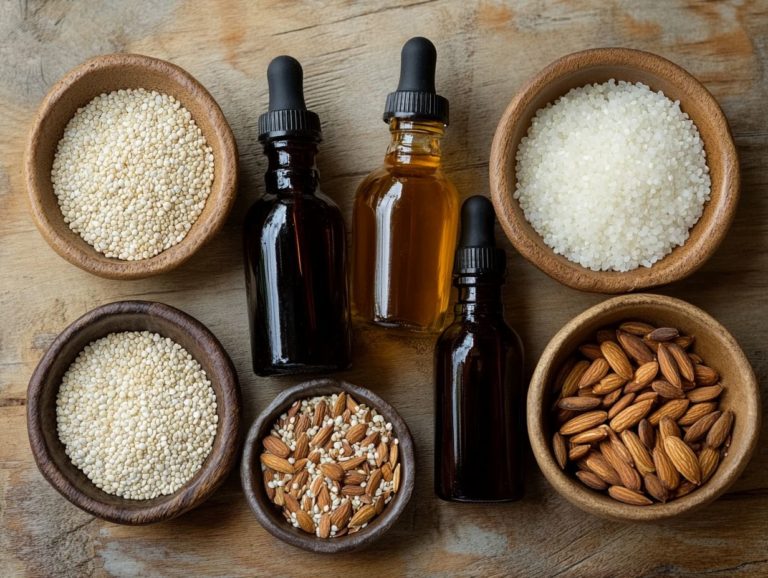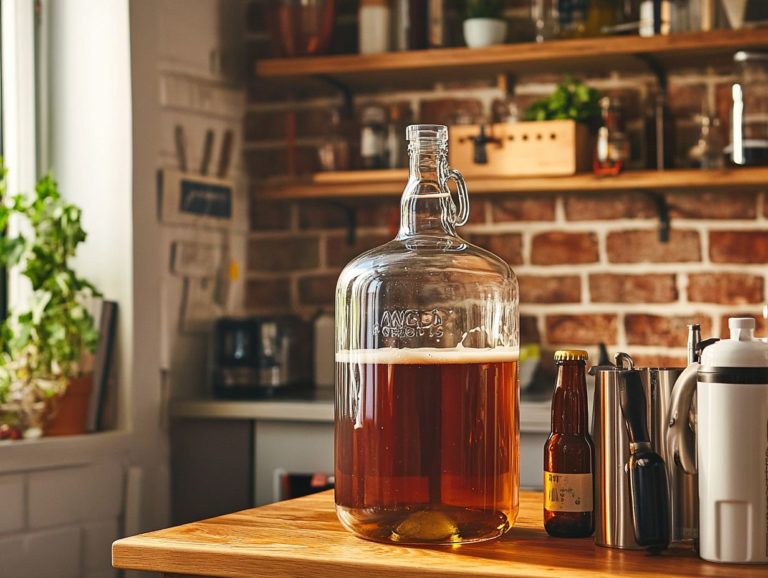What Are the Key Ingredients for Ales?
Ales occupy a cherished place in the world of beer. They are celebrated for their diverse flavors, unique brewing methods, and the rich brewing traditions that accompany them.
This article invites you to explore what ales truly are. It delves into their defining characteristics, fermentation process, and the key ingredients that set them apart. It takes you on a journey through the various types of ales, from pale ales to IPAs, illuminating the distinctions that separate them from lagers.
For those aspiring to brew at home, a comprehensive step-by-step guide will be included. This guide empowers you to create your own delightful ales while experimenting with various hop varieties, yeast strains, and brewing methods.
Get ready to dive into a flavorful adventure!
Contents
Key Takeaways:
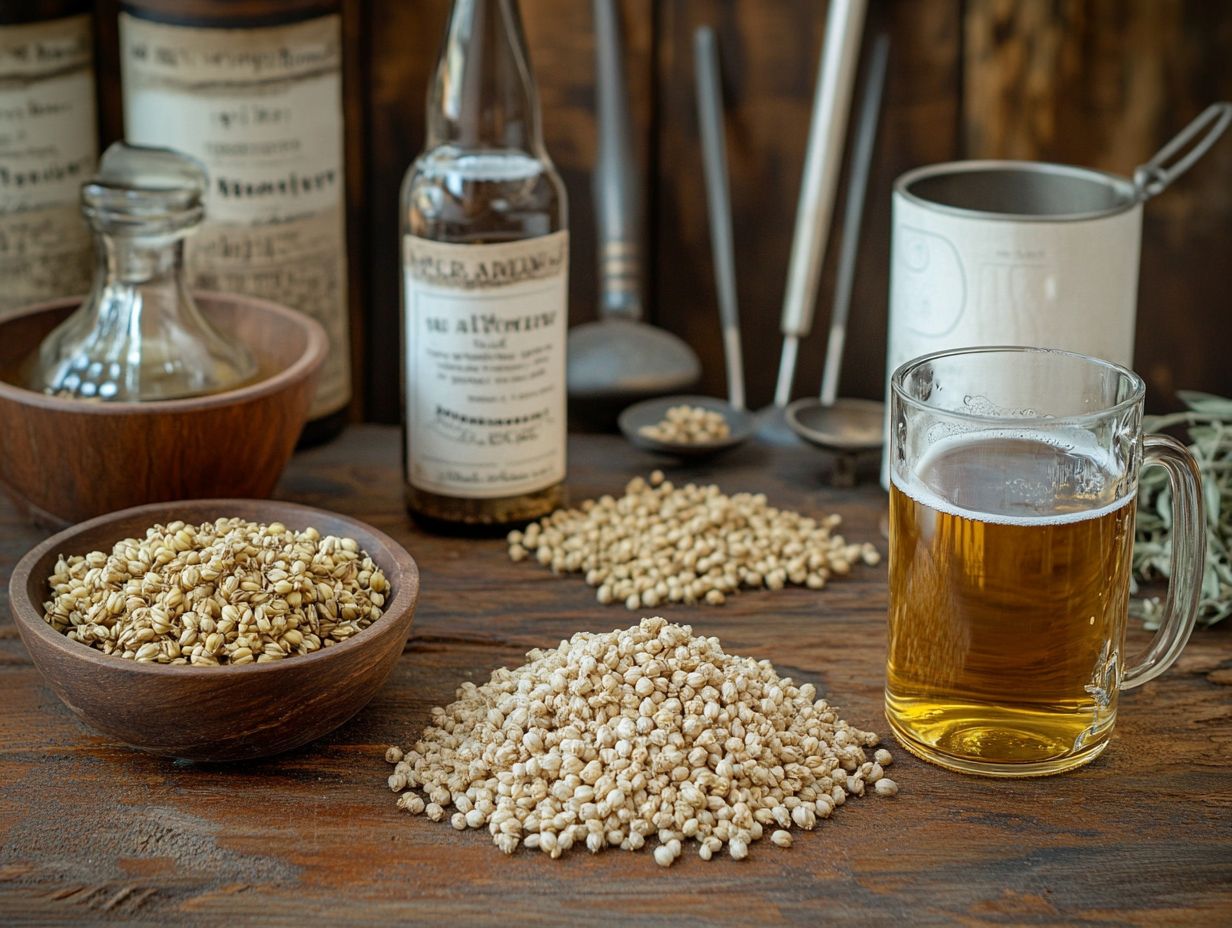
- Ales are a type of beer that use malt, hops, yeast, and water as their main ingredients.
- The main types of ales include pale ales, IPAs, brown ales, amber ales, and wheat ales, each with its own distinct brewing yeast and hop varieties.
- Ales differ from lagers in terms of fermentation process and flavor profile.
What Are Ales?
Ales are a diverse category of beer. They are celebrated for their robust flavors and aromatic profiles.
Ales are typically crafted through a process called top fermentation, where yeast rises to the top of the liquid during fermentation. This brewing method sets ales apart from lagers. It creates a stunning range of unique flavors from the careful interplay of malt, hops, and yeast strains.
As a result, ales have captivated the hearts of beer enthusiasts. They showcase a complexity that spans from fruity and spicy notes to rich, malty undertones. It’s no wonder they have become a cornerstone of the craft beer movement.
What Are the Main Ingredients for Ales?
Ales mainly consist of four essentials: malt, hops, yeast, and water. Each ingredient plays a vital role in shaping the overall flavor, aroma, and quality of your beer.
Malt is usually sourced from grains such as barley, wheat, rye, and oats. It provides the essential sugars necessary for fermentation. Hops contribute bitterness and aromatic qualities that elevate the beer s profile.
Your choice of yeast strain is equally important. It significantly influences the fermentation process, determining the final alcohol content and the distinct flavors that characterize various ale styles.
The type of water you use, whether soft, hard, acidic, or alkaline, can profoundly affect the brewing process and the beer s unique characteristics.
1. Malt
Malt is an essential element in ales, primarily derived from grains like barley. This grain undergoes a meticulous malting process designed to enhance its sugars and flavor profile.
You start by soaking the barley in water, allowing it to germinate, and then drying it to stop the germination process. The result? Malted barley, ready to be crushed and integrated into your brewing endeavor.
The malting process is vital not just for developing sugars but also for producing a range of malt types, each with its own distinct characteristics that significantly impact the final brew.
From pale malts that lend a subtle sweetness and light color to darker malts that infuse rich flavors reminiscent of chocolate or coffee, you have an extensive palette at your disposal.
Malt interacts beautifully with hops, yeast, and water, crafting a balanced and harmonious profile that is crucial for high-quality ales. By grasping these nuances, you enable yourself to create distinctive beverages that cater to a wide array of tastes and preferences.
2. Hops
Hops play a crucial role in brewing ales, offering both bitterness and aroma that perfectly balance the sweetness of the malt. With a plethora of hop varieties at your disposal, each one contributes unique flavors and fragrances that can range from floral and citrusy to earthy and spicy, depending on when you choose to add them during the brewing process.
To truly appreciate these contributions, it s important for you to distinguish between bittering hops, aroma hops, and dual-purpose hops. Bittering hops are typically added early in the boiling stage, imparting the essential bitterness that defines many beer styles. In contrast, aroma hops are introduced later to safeguard their volatile oils, infusing the final product with enchanting scents that elevate the drinking experience.
Dual-purpose hops offer versatility, delivering both bitterness and aromatic qualities, which allows you to experiment with a variety of flavor profiles. The thoughtful selection of hop varieties can significantly influence specific ale styles, enabling you to craft everything from hop-forward IPAs to nuanced, balanced porters and stouts, thus elevating your brewing artistry to new heights. By integrating hop oils extracted from hop cones, you can further refine and customize the aroma and bitterness of your ales.
3. Yeast
Yeast is a critical ingredient in your brewing journey, acting as the catalyst for fermentation by transforming the sugars from malt into alcohol and carbon dioxide. You’ll find that different yeast strains can yield a fascinating array of flavors and aromas, each significantly shaping the final character of your ale.
The yeast strain you select can lead to an impressive range of taste experiences, from the delightful fruity esters produced by certain strains to the intriguing spicy phenols imparted by others. This choice is pivotal for you as a brewer, as the yeast’s characteristics can elevate or completely transform the intended flavor profile of your ale.
Fermentation is a nuanced process, where yeast not only produces alcohol but also adds depth to the mouthfeel and overall complexity of your brew. By grasping the roles that various yeast varieties play in this intricate dance, you’ll be enabled to craft unique ales that appeal to a spectrum of palates. In essence, your choice of yeast becomes a foundational element of your brewing artistry. Understanding different fermentation processes, including the role of brewing yeast and the impact of yeast strains, can elevate your brewing skills significantly.
4. Water
Water is often an overlooked yet essential ingredient in brewing ales, with its mineral content playing a pivotal role in shaping the beer’s flavor and overall quality. Depending on the source, water can fall into categories such as soft, hard, acidic, or alkaline, each bringing unique characteristics to the brewing process.
Soft water, for instance, generally lends itself well to lighter ales like pale ales and pilsners, allowing the delicate hop flavors to emerge beautifully. In contrast, hard water rich in minerals like calcium and magnesium can enhance the body and malt character, making it a better fit for darker ales such as stouts and porters.
As a brewer, you have the power to adjust the water chemistry by adding specific minerals or acids, achieving the perfect balance for your desired ale style. By mastering this manipulation, you not only create complex flavor profiles but also ensure consistency across batches, ultimately resulting in a more refined and enjoyable beer experience.
Furthermore, the use of different types of water such as soft water, hard water, acidic water, or alkaline water can significantly impact your brewing process and the final quality of your craft beers.
What Are the Different Types of Ales?
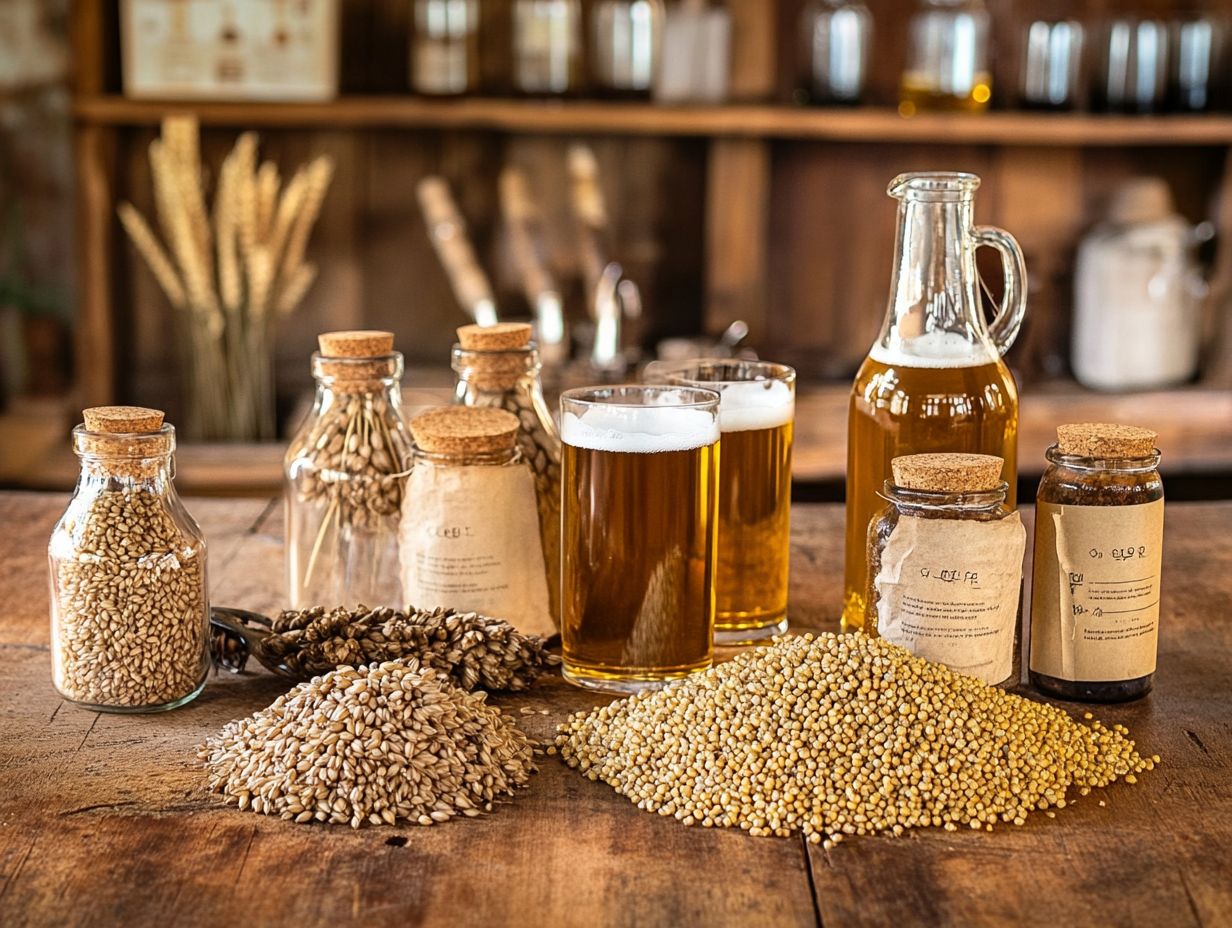
Dive into the exciting world of ales where you’ll find a plethora of ale varieties, each boasting its own unique characteristics and flavor profiles. From the refreshing crispness of pale ales to the bold hop-forward punch of India Pale Ales (IPAs), the rich depth of brown ales, the balanced sweetness of amber ales, and the light, effervescent nature of wheat ales, the world of ales is truly captivating.
These distinct styles arise from variations in ingredients and brewing methods, creating an impressive selection of craft beers designed to please even the most discerning palates. Regional varieties crafted by New England breweries or New Trail Brewing Co. offer unique flavors that reflect their specific brewing traditions and local ingredients.
1. Pale Ales
Pale ales stand out as a beloved beer style, easily recognizable by their golden hue and a harmonious blend of malt and hop flavors. This makes them appealing to a broad audience. You’ll typically notice a delightful hop presence that brings a refreshing bitterness, all wrapped up in a light to medium body.
This style traces its roots back to 18th-century England, where pale malts were first used, lending those distinctive colors and flavors. Among the notable examples, the classic English Bitter offers earthy and floral hop notes. In contrast, the American Pale Ale takes a bold leap with its vibrant citrus and pine flavors, thanks to the use of innovative hop varieties.
Brewing techniques vary among different brewers, offering unique takes on each ale. Many brewers favor a balanced fermentation process that highlights the dance between malt sweetness and hop bitterness. You ll also find regional variations like those from Australia or New England that introduce exciting twists on the classic style, inviting enthusiasts like you to explore a diverse spectrum of flavors.
2. India Pale Ales (IPAs)
India Pale Ales (IPAs) are a celebrated type of ale, renowned for their intense hop bitterness and captivating aroma. You ll often encounter a delightful array of hops that impart distinctive flavors and fragrances. This beer style has surged in popularity within the craft beer community, admired for its bold taste and often elevated alcohol content.
The fascinating origins of IPAs date back to the 19th century when British brewers crafted these ales with strong hop flavors specifically for export to India, ensuring that the beer remained enjoyable during the lengthy voyage. Over the years, IPAs have evolved into a cornerstone of the craft beer movement, embodying innovation and creativity among brewers. This demonstrates the rich history and brewing art that continues to inspire craft breweries today.
You can explore a variety of sub-styles, such as the hazy New England IPAs, celebrated for their juicy and fruity profiles, alongside the more traditional West Coast IPAs, which highlight resinous and piney hop characteristics. These styles reflect the diverse hop varieties and brewing methods utilized by brewers to achieve unique flavors.
The diversity in hop varieties from Citra to Simcoe, Mosaic to Centennial allows craft breweries to experiment with flavor and aroma profiles that truly enchant the palates of beer enthusiasts. These hops can be categorized into aroma hops, bittering hops, and dual-purpose hops, each contributing different characteristics to the final brew.
In conclusion, exploring the different types of ales not only enhances your appreciation for craft beers but also allows you to experience the rich tapestry of flavors and brewing techniques that each style offers. Whether you prefer the light crispness of pale ales or the bold characteristics of IPAs, there’s an ale out there for everyone.
3. Brown Ales
Brown ales are distinguished by their rich, malt-forward profiles that reveal delightful notes of nutty, caramel, and toasty flavors. The darker hue of these ales comes from using roasted malts. This results in a smooth and satisfying drinking experience.
This style typically utilizes barley and occasionally wheat or oats to enhance complexity. Your brewing journey begins with the careful selection of high-quality base malts, usually starting with pale malt. Specialty malts complement the base, enhancing the flavor’s depth.
Once you mash the grains, boil the wort (the liquid extracted from the mashing process before fermentation), and add hops at various intervals. This creates a balance with the sweetness of the malt. The addition of hops at different stages yields contrasting aroma and bitterness levels in the final brew.
The fermentation process, powered by yeast, is crucial in shaping the final taste. Different yeast strains can introduce an array of fruity or earthy notes. Using various brewing yeast can lead to incredible diversity in beer styles.
What emerges is a captivating spectrum of flavors. Consider Newcastle Brown Ale from England, celebrated for its slight bitterness paired with caramel sweetness. American interpretations often feature a more pronounced hop profile, showcasing the versatility and charm of this cherished style.
4. Amber Ales
Amber ales present a beautifully balanced style of beer that artfully blends malt sweetness with hop bitterness. This results in a medium-bodied ale adorned with a captivating amber hue. You ll often find flavors that dance between caramel and toasty malt, harmonized by a moderate hop presence.
To achieve this exquisite balance, brewers select specific malts such as Crystal and Munich, which impart rich caramel notes. Hops like Cascade and Centennial contribute delightful floral and citrus undertones.
Regional variations of amber ales can be striking. For example, West Coast versions flaunt a more pronounced hop aroma, while their East Coast counterparts often embrace a malt-forward profile.
Famed examples like Fat Tire from New Belgium and Bell’s Amber Ale showcase unique characteristics, giving you a taste of the diverse artistry behind this cherished style.
5. Wheat Ales
Wheat ales are crafted using a notable proportion of wheat alongside barley. This results in a refreshing, often hazy appearance that beckons to be savored. Dive into the refreshing light body of these ales!
These ales typically boast fruity and spicy notes derived from specific yeast strains, such as Belgian or Hefeweizen yeasts, which impart delightful aromas of banana and clove. The brewing process marries traditional techniques with innovative approaches, allowing for an array of flavor interpretations.
The use of soft water, hard water, and even acidic or alkaline water can significantly influence the final product. Renowned craft breweries like Allagash Brewing Company and Schneider Weisse create exceptional variations of this style, each presenting distinct profiles shaped by their chosen ingredients.
For instance, some may emphasize citrusy hops or a hint of coriander, elevating the complexity and refreshing essence of the final product. Are you ready to explore the world of wheat ales?
How Are Ales Different from Lagers?
Ales and lagers represent two distinct categories of beer, each with unique characteristics rooted in their fermentation processes and flavor profiles. The types of grains used, such as barley, wheat, and even rye, can also play a significant role in defining these styles.
When you savor an ale, you’re experiencing the art of top fermentation, where yeast rises to the top during the brewing process. In contrast, lagers undergo bottom fermentation at cooler temperatures, resulting in a different experience altogether.
This fundamental difference not only influences the type of yeast employed but also shapes the beer’s taste, aroma, and overall character.
Ales tend to exhibit a more complex and fruity essence, while lagers offer a clean and crisp finish that refreshes the palate.
1. Fermentation Process
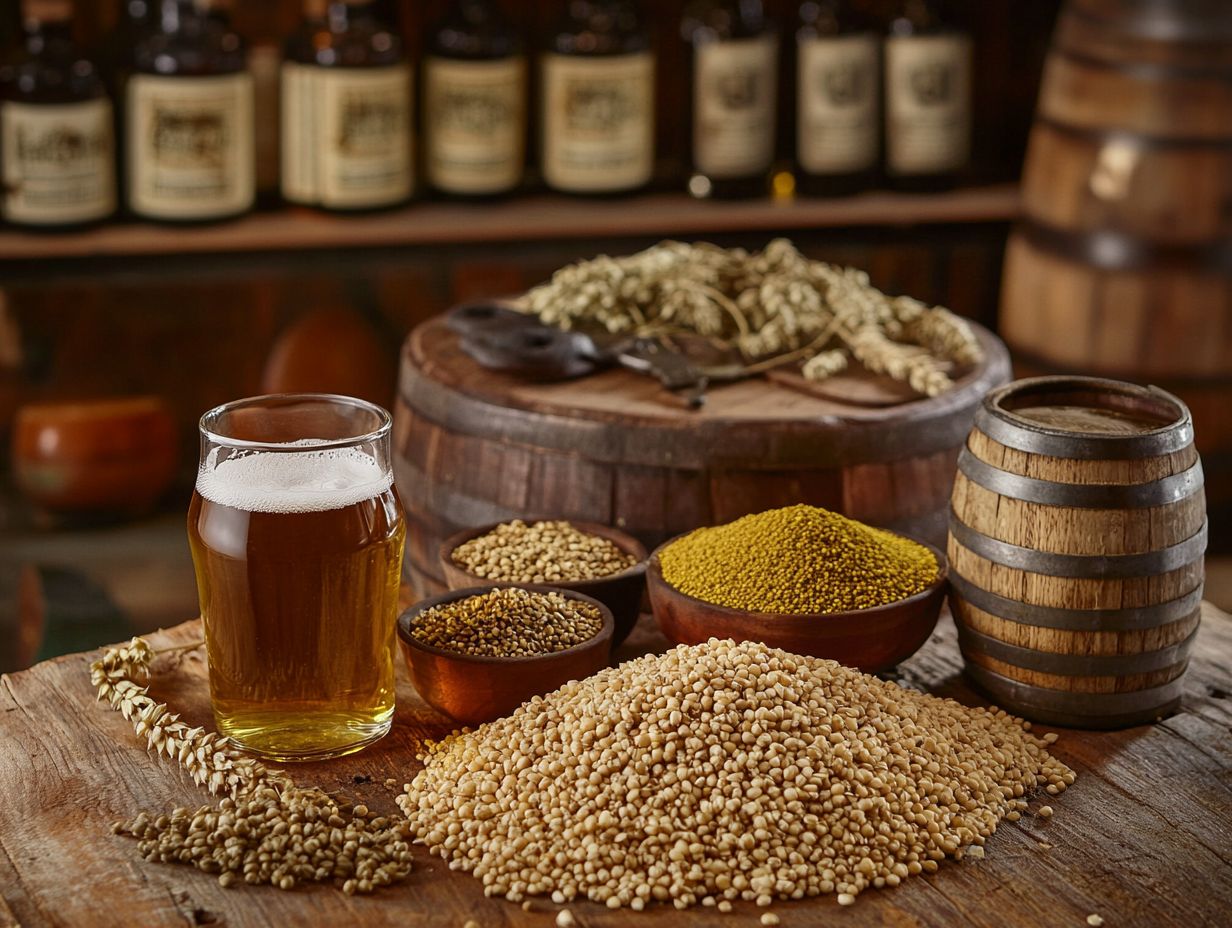
The fermentation process is where ales and lagers really diverge and is fascinating. Ales undergo top fermentation at warmer temperatures, which means they ferment faster and develop a rich tapestry of complex flavors.
In contrast, lagers are fermented at cooler temperatures using bottom-fermenting yeast, resulting in that signature clean and crisp taste. This process also influences the formation of alcohol and carbon dioxide, key components in beer’s final character.
This difference primarily stems from the yeast strains employed. Ales typically use Saccharomyces cerevisiae, which thrives in a cozy range of 60 to 75 F, crafting esters and phenols compounds that contribute fruity and spicy flavors to the brew. Meanwhile, lagers use Saccharomyces pastorianus, which prefers a cooler environment between 45 and 55 F.
This slower fermentation process minimizes flavor byproducts, allowing the malt and hop characteristics to truly shine. Take an IPA, for instance an ale that bursts with citrus and pine notes. In contrast, a pilsner a classic lager offers a refreshing, clean finish that beautifully highlights its malty sweetness. The distinctions are not just technical; they re a celebration of the art of brewing.
2. Flavor Profile
The flavor profile of ales is often a delightful medley of fruity, spicy, and complex notes, thanks to the top fermentation process and the specific yeast strains used in brewing. In contrast, lagers present a cleaner, more subdued flavor profile that highlights malt and hops without the fruity esters typical of many ales.
When you reach for a lively India Pale Ale (IPA), you can expect vibrant citrus and pine flavors that will surely satisfy your craving for bold, hoppy tastes. Meanwhile, indulging in a rich stout like Guinness will treat you to roasted malt flavors, beautifully complemented by chocolate and coffee notes, perfect for those who appreciate deeper, more intense profiles.
On the flip side, lager varieties such as Pilsner and Helles offer a refreshing crispness often described as easy-drinking, making them the ideal choice for light beer enthusiasts. This distinct separation in flavor profiles allows you to explore a range of experiences, ensuring there s something to delight every palate.
How to Brew Ales at Home?
Brewing ales at home offers a gratifying and enjoyable journey, inviting you to explore various ingredients and techniques to craft distinctive flavors that reflect your personal palate. Start your brewing adventure today and unlock flavors that are uniquely yours! Experimenting with different water profiles, such as soft or hard water, can also help you achieve the desired quality in your homebrew.
To embark on this rewarding venture, you ll need to collect the fundamental ingredients malt, hops, yeast, and water alongside the essential equipment that will streamline your brewing process.
Conclusion
In summary, ales and lagers showcase the incredible variety and artistry of brewing. Ales are characterized by their fruity and complex profiles, while lagers deliver a refreshing and crisp drinking experience. Whether you choose to brew your own or explore the vast landscape of beer styles, there’s always something exciting to discover. Try brewing your own ales and share your experiences with fellow enthusiasts!
Brewing Ales at Home
1. Gather Ingredients and Equipment
The first step in your journey to brewing exceptional ales at home is to gather all the necessary ingredients and equipment. Get ready to gear up with essential brewing equipment that will elevate your craft!
- High-quality malt
- Hops
- Yeast
- Water
Essential brewing tools include:
- Fermentation vessel
- Brew kettle
- Thermometer
Remember, the quality of your ingredients is paramount for achieving the desired flavor and aroma in your finished ale.
Each of these components plays a crucial role in the brewing process. Malt serves as the backbone of your ale, providing the essential sugars needed for fermentation. Hops contribute bitterness and aromatics, creating a delightful balance against the sweetness of the malt.
Yeast takes center stage during fermentation, transforming sugars into alcohol and carbon dioxide, which adds unique character to your brew. Don’t underestimate the importance of water; it’s often overlooked but constitutes the majority of your beer and can significantly influence both taste and clarity.
You’ll need essential equipment like a fermentation vessel, which allows for proper gas release and helps prevent contamination, and a brew kettle, which is vital for boiling your mixture. Utilizing a thermometer is key to maintaining optimal temperatures for yeast activity, directly impacting the quality of your final product.
High-quality ingredients can be sourced from local homebrew shops or reputable online suppliers, ensuring both freshness and authenticity in every batch you create. Whether you choose to use barley, wheat, rye, or oats, your choice of ingredients dramatically shapes the taste and aroma of your beer. Start gathering your ingredients today and embark on your home brewing adventure!
2. Mashing and Boiling
Mashing and boiling are pivotal stages in your brewing process. Here, you mix the malt with hot water to extract those precious fermentable sugars, followed by boiling the wurt the liquid extracted from the malt and adding hops for that perfect blend of flavor and bitterness.
This meticulous process sets the foundation for your ale s character, influencing its aroma and overall quality. During the mashing phase, it s crucial to maintain the right temperature, typically between 150 F to 160 F (65 C to 71 C), for about an hour to ensure optimal enzymatic activity. This is the moment when the starches in the malted barley transform into fermentable sugars, essential for brewing.
Once mashing wraps up, you ll drain the wort and bring it to a vigorous boil. Here, you introduce the hops those key flavoring agents at just the right moment. Their type and timing, whether they are aroma hops, bittering hops, or dual-purpose hops, can dramatically impact the beer’s bitterness, aroma, and complexity.
These carefully monitored steps are vital in crafting a balanced flavor profile that defines your final brew, ensuring high-quality craft beers.
3. Fermentation and Conditioning
Fermentation and conditioning are essential steps in your brewing journey. You’ll transfer the wort to the fermentation vessel and introduce brewing yeast, kickstarting the magical transformation of sugars into alcohol and carbon dioxide. This phase can span several days to weeks, hinging on the yeast strain you select and the flavor profile you aim to create.
As the fermentation process unfolds, the yeast eagerly consumes the sugars in the wort, yielding alcohol and enriching the ale with complex aromas and flavors. Different yeast strains contribute a variety of notes, from fruity hints to spicy undertones, ultimately shaping your final brew. Monitor the fermentation progress closely; you can use a hydrometer to check specific gravity and gauge sugar levels.
Following fermentation, conditioning is where the magic continues. This stage allows your beer to mature, enhancing clarity and taste as unwanted compounds settle out, akin to what occurs in craft breweries. It s also the perfect opportunity to carbonate the ale naturally, giving it that delightful effervescence and enhancing the overall mouthfeel a hallmark of well-crafted beer styles.
In summary, brewing ales at home involves gathering quality ingredients, mastering the mashing and boiling stages, and allowing your beer to ferment and condition properly. With each step, you enhance the flavors and aromas that make your brew unique and enjoyable. Cheers to your brewing adventure!
Bottling and Carbonation
Bottling and carbonation are the thrilling final steps in your brewing adventure! These processes bring your brewing journey to a delightful conclusion, allowing you to package your ales, lagers, stouts, or any other beer styles for enjoyment.
Once fermentation wraps up, you ll pour the ale into bottles, often adding a pinch of sugar to spark that crucial carbonation, transforming your brew into a refreshing and effervescent delight.
To ensure this process unfolds without a hitch, it s imperative to sterilize all your brewing equipment thoroughly. This step is essential to avoid any contamination that could compromise the ale’s flavor.
When it comes to capping, consider your techniques carefully. Using the right bottle caps and a reliable capping machine will create a tight seal, keeping unwanted air and contaminants at bay.
Carbonation is crucial for your ale s mouthfeel; it provides that lively texture that elevates the overall drinking experience, a testament to the quality of the brewing process.
As you embark on bottling at home, pay attention to adding just the right amount of sugar and giving it enough time for natural carbonation to occur. This careful approach reflects the meticulous nature of the brewing methods you ve employed and will lead to a well-balanced and enjoyable beverage that you can truly savor.
Frequently Asked Questions
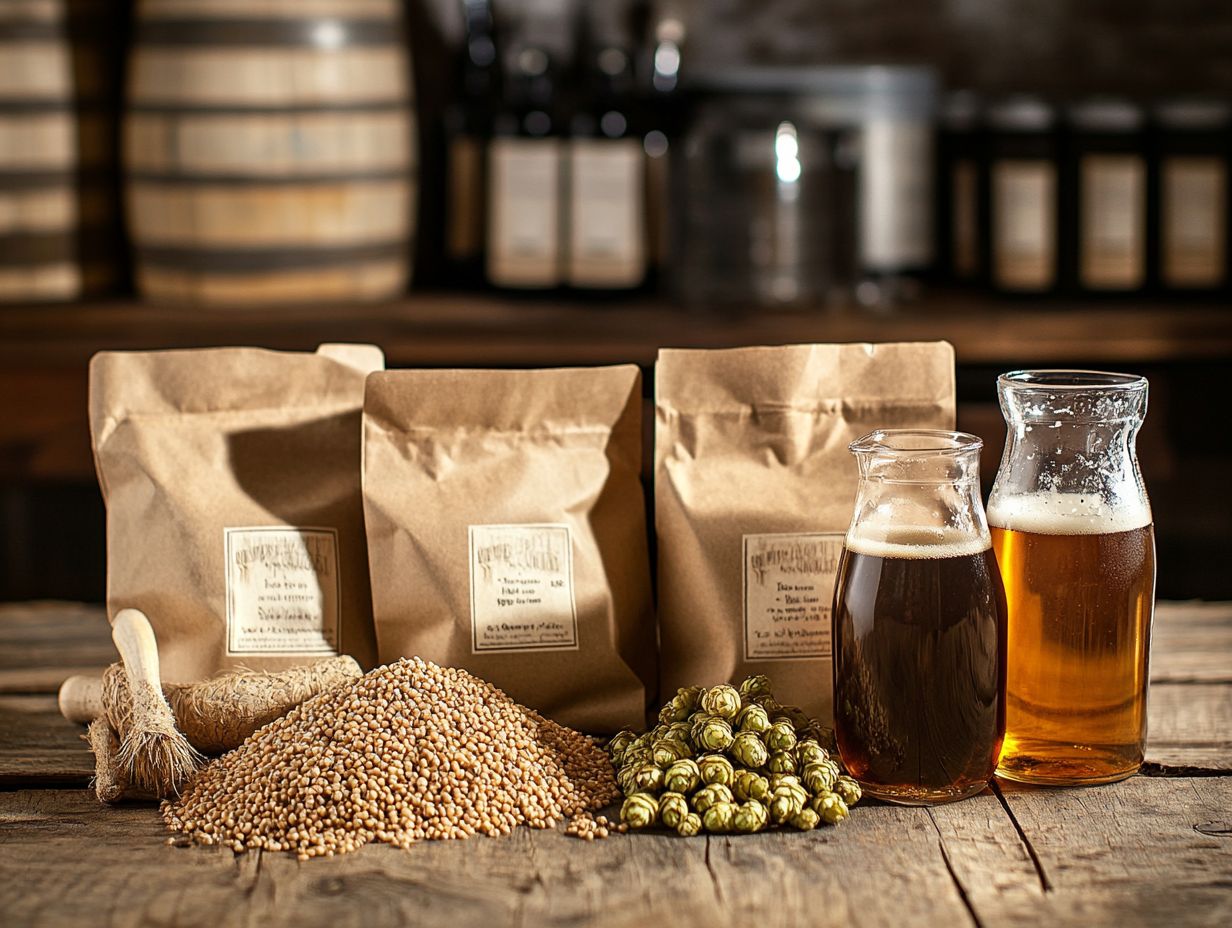
What Are the Key Ingredients for Ales?
Ales are a type of beer that is brewed with specific ingredients to give them their distinct flavor and aroma. These are the key ingredients used in making ales, whether crafted in large breweries or small craft breweries:
What is the main ingredient in ales?
The main ingredient in ales is malted barley. This grain, a result of the malting process, provides fermentable sugars that will be converted to alcohol during the brewing process.
Do ales contain any hops?
Yes, ales do contain hops. Hop cones are added during the brewing process to provide bitterness, flavor, and aroma to the beer. They also act as a natural preservative.
What other ingredients are commonly used in ales?
Apart from malted barley and hops, ales may also contain other ingredients such as yeast and water (which can be soft, hard, acidic, or alkaline). Sometimes additional grains like wheat, rye, or oats are included, adding complexity and depth to the flavor of the ale.
Are there any special ingredients used in ales?
Some ales may also use special ingredients to give them a unique flavor profile, including fruits, spices, or herbs. These can be added during the brewing or fermentation processes.
How do these ingredients affect the taste of ales?
The combination of malted barley, hops, yeast, and other ingredients significantly impacts the overall taste of the beer. Different ratios and types of these ingredients, including various hop varieties and brewing yeast, create a wide range of flavors and aromas, making ales a versatile and diverse style celebrated for its unique flavors across regional varieties.
Start brewing your own ales today and share your experiences!


